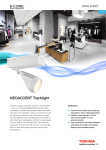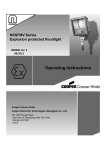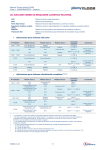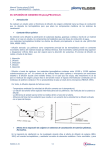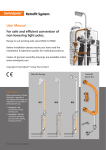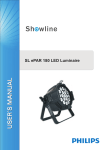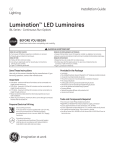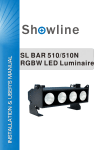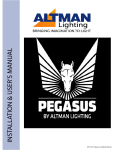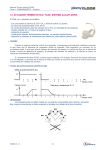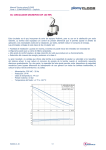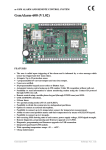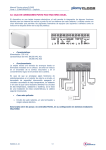Download Operating Instructions - CROUSE
Transcript
EVZ Series (Small body) Explosion protected luminaire Operating Instructions Cooper Crouse-H i n d s Cooper E l ec t ron i c T ec h n ol og i es ( S h a n g h a i ) Co. , L t d . No. 955 Shengli Road, East Area of Zhangjiang High-Tech Park, Shanghai 201201 China 1. Dimensions 2. Technical data Hazardous area specification Type of protection: Ex de (Flameproof, Increase Safety) ATEX classification: Group II Category 2 G Certification Marking: II2 G Ex d e IIC T…Gb Ambient temperature: -40ºC~+55ºC Temperature class: Refer to Type configuration EC type examination Certification No.: T V 11 ATEX 7092 X 4. Safety Instructions This product should be installed, inspected, and maintained by a qualified electrician only, in accordance with national regulation, including the relevant standard and, where applicable, in acc. with EN/IEC 60079-17 on electrical apparatus for explosive atmospheres. The national safety rules and regulations for prevention of accidents and the following safety instructions in these operating instructions, will have to be observed! IECEx Certificate No.: IECEx CQM 11.0002 Degree of protection: IP 66 acc. to EN60529/IEC60529 Approval of the production Quality assurance: Baseefa ATEX 5952 Enclosure specification Material of enclosure: Metal alloy aluminum without Cu Finish: Painted polyester power coat grey Material of glass: Tempered glass Mounting plate: Stainless steel or painted power coat Fasteners: All external fasteners stainless steel Installation: Mounting bracket with aiming quadrant Weight: Refer to Type Configuration. Entry specification Indirect entry: 2 M20 1.5 or 2 M25 1.5 or 2 NPT3/4” cable entry. One entry is fitted with an Exe stopping plug. Electrical specification The luminaires must not be operated in Zone0 and in Zone20! Before opening, electrical power to the luminaire must be turned off for at lease 10 minutes! Do not install where the marked operating temperature exceed the ignition temperature of the hazardous atmosphere. Do not operate in ambient temperatures above those indicated on the luminaire nameplate. The lumininaires shall be operated as intended and only in undamaged and perfect conditions! Keep tightly closed when in operation! The technical data indicated on the lumininaires are to be observed! Change of the design and modifications to the luminaires are not permitted! Multiple, short-term switching must be observed! Only genuine Cooper Crouse-Hinds spare parts may be used for replacement! Repairs that affect the explosion protection, may only be carried out by Cooper Crouse-Hinds or qualified electrician! Do not keep these operating instructions inside the luminaires during operation! Wattage: 70W/100W/150W Voltage: 220V/230V 50/60Hz, 240V 50Hz Lampholder: E27/E40 Insulation class: I acc. to IEC60598 Terminals capacity: 3 or 6 core conductor/cable Solid 0.5~6mm2 Flexible 0.5~4mm2/0.5~6mm2 Lamp: High pressure Sodium/Metal Halide 3. Conformity with standards This explosion protection luminaires meet the requirements of EN/IEC60079-0, EN/IEC60079-1, EN/IEC60079-7, It also complies with the EC Directives for “Apparatus and protective system for use in explosion atmospheres”(94/9/EC). It has been designed, manufactured and tested in accordance to the state of the art and according to ISO 9001:2000. The luminaires are suitable for use in explosive atmospheres, Zone1,Zone2 according to IEC60079-10-1 IM0060.Revision 2 08/12 5. Field of Application The ATEX category 2 G Luminaire with a separate Exe terminal box utilizes Exde protection and IP66 sealing making it suitable for use for potentially explosive atmospheres including ignitable gas and dust applications. The luminaire is designed for use in Zone1/Zone21 hazardous areas in indoors and outdoors in Marine and Wet locations, where moisture, dirt, corrosion, vibration and rough usage may be present. Application ambient temperature is -40ºC~+55ºC. Refer to the luminaire nameplate for specific classification information, maximum ambient temperature suitability and corresponding operating temperature (T- Number). The enclosure materials used, including any external metal parts, are high quality materials that ensure a corrosion resistance and resistance to chemical substances according to the requirements for use in a “normal“ industrial atmosphere. In case of use in an extremely aggressive atmospheres, please refer to manufacture. Cooper Electronic Technologies (Shanghai) Co., Ltd Page 1 of 3 6. Type configuration Without Reflector Watt Std. Cat No. (W) Lamp T Class (Gas) Voltage T With Reflector (Dust) T Class (Gas) T (Dust) Lampholder +40ºC +50ºC +55ºC +40ºC +50ºC +55ºC +40ºC +50ºC +55ºC +40ºC +50ºC +55ºC Weight (Kg) EVZIS*07*** 70 HPS E27 T5 T5 T4 83 93 98 T4 T4 T4 100 110 115 EVZIM*07*** 70 E27 T5 T5 T4 83 93 98 T5 T4 T4 93 103 108 10 EVZIS*10*** 100 220V 50Hz 230V 50Hz HPS 240V 50Hz MH 220V 60Hz HPS 230V 60Hz MH E40 T5 T4 T4 94 104 109 T4 T4 T4 110 120 125 11 EVZIM*10*** 100 EVZIS*15*** 150 EVZIM*15*** 150 MH Permissible angle of 0 /30 10 E27 T4 T4 T4 97 107 112 T4 T4 T4 112 122 127 11 E40 T4 T4 T4 113 123 128 T3 T3 T3 136 146 151 12 E27 T4 T4 T4 111 121 126 T3 T3 T3 133 143 148 12 7.4 Opening/closing the luminaire 7. Installation 7.4.1 General The opening of luminaire always shall be The respective national regulations IEC/EN without voltage! 60079-14 as well as the general rules of All gasket seals must be clean and undamaged engineering which apply to the installation and before closing the luminaire. operation of explosion protected apparatus will Make sure the luminaires is well closed have to be observed! before operation! Do not install where the marked operating There are Exd thread joints between the temperature exceed the ignition temperature housing and the globe and between the of the hazardous atmosphere! housing and top hat! Do not operate in ambient temperatures Top hat has been fixed to the housing by the above those indicated on the luminaire manufacturer before delivery, and the Exd nameplate! thread joint has been tightened by the set The improper installation and operation may screw which is not permitted to be loosen by result in the explosion protection and the user. invalidation of the guarantee. 7.4.2 Terminal cover 7.2 Mounting luminaire Unscrew the screws and remove the terminal compartment cover. 7.2.1 Mounting the bracket Only use the accompanying mounting bracket! Carry out the steps in reverse order to close the luminaire. Securely fasten the mounting bracket to a Check all screws to ensure a secure fit suitable base with sufficient load- bearing (Torque for screws: 1.5 Nm). capacity. See Fig.1 and Fig.2 for detail. 7.1 General Fig. 1 Luminiare adjustment for bracket mounting Permissible angle of 0 /20 7.2.2 Adjustment of floodlight Loosen the set screw and fixing screws to rotate the bracket to set the required tilt angle between 0 and 30 and 0 and 20 according to different mounting bracket. Re-tighten the set screw and fixing screws . The lamp must not be illuminated when at a distance of less than 0.5m from inflammable material. Fig. 2 Luminiare adjustment for pole bracket Fig.3 Tighten & Loose of Globe Assembly Prepare the conductor as the drawing before connect it to the earth crew. Fig. 4 Electrical connection IM0060.Revision 2 08/12 7.2.3 Guard/Reflector installation Optional Reflectors • Angle reflector RA725 • Dome reflector RD725 The optional reflectors are attached to the luminaire as follows: Loosen three screws on globe housing and Position reflector over globe. When correctly placed, three holes in reflector will match three holes on globe housing. Thread screws into globe housing. Note: The same screws are used to attach the reflector and guard. If they used together, the reflector must be installed first. 7.4.3 Globe Loosen the set screw in the ballast housing and unscrew the globe from ballast housing. To ensure that the globe assembly is in-line with the ballast housing, rotate the globe assembly through 180 anti-clockwise in order to accurately line up the threads, then thread globe assembly onto ballast housing until assembly seats firmly against O-ring. Tighten the set screws to secure globe housing. Note: If globe assembly resists turning, insert a straight blade screwdriver in jacking slot and pry loose (see Figure 3). 7.5 Electrical connection The electrical connection of the lamp must only be established by qualified electricians. Make sure the supply voltage is the same as the luminaire voltage! Use proper supply wiring as specified on the nameplate of the luminaire and in this instructions! Excessive tightening may affect or damage the connection. See section 7.4 for notes on opening and closing the luminaire. Connect cable according to the 7.3 Cable entries/blanking plugs terminal numbering and circuit diagram. The “Increased safety (Exe)" properties must The conductors shall be connected with special be preserved when, for example, using cables care in order to maintain the explosion category. and wires of sufficient diameter. Unused holes Leads connected to the terminals shall be shall be closed with a certified blanking plug in insulated for the appropriate voltage and this order to establish the Exe protection category. insulation shall extend to within 1mm of the metal The cable glands and blanking plugs should be of the terminal throat. Ex tD certified if the whole product is Ex tD The conductor itself shall not be damaged. certified also. The authoritative mounting The connectible min. and max. conductor crossguidelines for the cable glands used must be sections shall be observed (see technical data). observed. Mounting the selected cable entries All terminal screws, used and unused, shall be (cable glands) acc. type and dimensions of the tightened down to between 1.2~2Nm for MK/6 main connection cable. Following their and 0.5~0.7Nm for BK. manufacturer instructions. Main connection: See wiring diagram. Cooper Electronic Technologies (Shanghai) Co., Ltd Page 2 of 3 (Optional terminals) Fig. 5 Wiring Diagram (HPS/MH) 9. Maintenance/Servicing 9.1 General The relevant national regulations which apply to the maintenance/servicing of electrical apparatus in explosive atmospheres, shall be observed (EN/IEC 60079-17). The interval between maintenance depends upon the ambient conditions and the hours of operation. The recommendations given within EN/IEC 60079-17 for recurring checks must be observed. 9.2 Checks During maintenance, the parts affecting the level of protection must be checked in particular: - Enclosure and glass for cracks and damage. - Seals for damage. - Terminal, screw glands and blanking plugs for secure fitting. - The flameproof joint have to be clean undamaged, without corrosion and perfect greased. - To maintain the light output, clean the protective glass and reflector Fig. 6 Family tree periodically with a damp cloth or a mild cleaning fluid. A complete EVZ luminaire consists of: A Housing Assy, Top hat Assy, -If this product is used in the combustible dust area, outside of enclosure Glob Assy, a mounting bracket, with or without guard and/or reflector. must be cleaned on a regular basis to prevent accumulation of dust. Cleaning the rests of grease and corrosion do not use sharp metallic devices that can damage the threads of the joint, and greasing them using appropriate grease terminally and chemically stable with a drop point 200 like e.g.: HTL lubricant from Cooper Crouse-Hinds! When the housing need to be repainted, pay attention that the flameproof joints test without any part with coating! 9.3 Lamp change The suggested interval between lamp changes given by the lamp manufacturer should be followed. Disconnect power to the luminaire and allow the luminaire to cool completely. See section 7.4 for notes on opening and closing the luminaire. If the luminaire was previously in operation then wait 10 mins. before opening. Ensure that no hazardous atmosphere is present. See section 7.6 for notes on inserting the lamp. 10. Repair/Overhaul/Modifications 10.1 General The national regulations ENIEC60079-19 have to be observed! Repairs and overhaul may only be carried out with genuine Cooper Crouse-Hinds spare parts. Before replacing or disassembling individual parts, observe the following: Disconnect the power supply to the equipment before maintenance/repair. Make sure that there is no explosive atmosphere when opening the equipment. See section 7.4 for notes on opening and closing the luminaire. Only use original spare parts. If the luminaire was previously in operation then wait 10 mins. 7.6 Lamp mounting before opening. Only must be mounting appropriated lamps for the supplied Repairs that affect the explosion protection, may only be carried luminaire see indications on the nameplate of the luminaire and in out by Cooper Crouse-Hinds or a qualified electrician in this instructions! compliance with the applicable national rules. See section 7.4 for notes on opening and closing the luminaire . The Modifications to the device or changes to its design are not lamp must be screwed tightly into the lampholder. permitted. Ensure it is screwed in fully so that no sparks or other unauthorized After carrying out repair or overhaul work, ensure that the “Exde" operating states may occur. Protect the glass on the lamp from properties have not been affected. breaking when screwing in. Assistance may also be obtained through Cooper Electronic Technologies (Shanghai) Co., Ltd. Sales Service department, 8. Putting into operation 955 ShengLi Road, Pudong Shanghai 201201. Prior to putting the apparatus into operation, the tests specified in the Phone (86) 21-28993600 relevant national regulations shall be carried out. Insulation measurements may only be carried out between PE and the 11. Disposal/Recycling external conductor L1 (L2, L3) as well as between PE and N. When the apparatus is disposed of, the respective national regulations - Measurement voltage: Max. 1 kV AC/DC on waste disposal will have to be observed. - Measurement current: Max.10 mA - The luminaire may only be operated when closed. IM0060.Revision 2 08/12 Cooper Electronic Technologies (Shanghai) Co., Ltd Page 3 of 3






